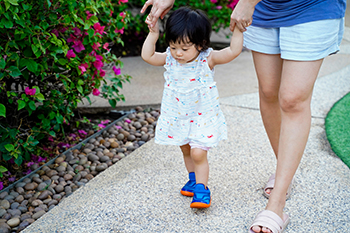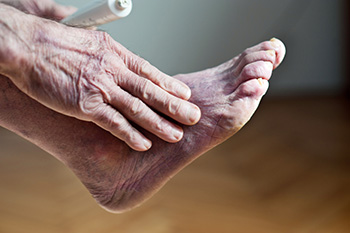Blog

Selecting the right shoes for your baby’s first steps is important for healthy foot development. For a typical foot, the best choice is a lightweight shoe with a wide toe box, flexible structure, and a minimalist sole to encourage natural movement. For a foot with low muscle tone, shoes should still be lightweight with a wide toe box, but include a firm heel cup, a higher toe box for extra space, and a high top design to provide added support and stability. A podiatrist can guide parents in choosing the right footwear to support proper growth, prevent future issues, and address any concerns about development. If you notice your child has foot pain, it is suggested that you contact this type of doctor who can accurately diagnose the condition, offer effective treatment solutions, and guide you toward choosing the correct shoes.
The health of a child’s feet is vital to their overall well-being. If you have any questions regarding foot health, contact Afshin Javaherian, DPM of Dr. Java Foot & Ankle Clinic. Our doctor can provide the care you need to keep you pain-free and on your feet.
Tips for Keeping Children's Feet Healthy
- Make sure their shoes fit properly
- Look for any signs of in-toeing or out-toeing
- Check to see if they have Clubfoot (condition that affects your child’s foot and ankle, twisting the heel and toes inward) which is one of the most common nonmajor birth defects.
- Lightly cover your baby’s feet (Tight covers may keep your baby from moving their feet freely, and could prevent normal development)
- Allow your toddler to go shoeless (Shoes can be restricting for a young child’s foot)
- Cut toenails straight across to avoid ingrown toenails
- Keep your child’s foot clean and dry
- Cover cuts and scrapes. Wash any scratches with soap and water and cover them with a bandage until they’ve healed.
If you have any questions, please feel free to contact our office located in Los Angeles, CA . We offer the newest diagnostic and treatment technologies for all your foot care needs.

As people age, changes in the blood vessels can limit circulation to the feet. This reduced blood flow means less oxygen and fewer nutrients reach the tissues, slowing the body’s ability to heal from cuts, sores, or infections. Skin on the feet may become thinner, drier, and more prone to injury. Seniors with poor circulation often feel persistent coldness or numbness, which can mask developing problems. Muscles in the lower legs and feet may weaken over time, affecting balance and stability. In severe cases, prolonged lack of blood supply can lead to tissue damage that requires urgent medical attention. Because the signs may be subtle at first, regular evaluation is important to detect issues early. If you are an older adult experiencing ongoing coldness, color changes, or delayed healing in the feet, it is suggested that you see a podiatrist for assessment and management.
Poor circulation is a serious condition and needs immediate medical attention. If you have any concerns with poor circulation in your feet contact Afshin Javaherian, DPM of Dr. Java Foot & Ankle Clinic. Our doctor will treat your foot and ankle needs.
Poor Circulation in the Feet
Poor blood circulation in the feet and legs is can be caused by peripheral artery disease (PAD), which is the result of a buildup of plaque in the arteries.
Plaque buildup or atherosclerosis results from excess calcium and cholesterol in the bloodstream. This can restrict the amount of blood which can flow through the arteries. Poor blood circulation in the feet and legs are sometimes caused by inflammation in the blood vessels, known as vasculitis.
Causes
Lack of oxygen and oxygen from poor blood circulation restricts muscle growth and development. It can also cause:
- Muscle pain, stiffness, or weakness
- Numbness or cramping in the legs
- Skin discoloration
- Slower nail & hair growth
- Erectile dysfunction
Those who have diabetes or smoke are at greatest risk for poor circulation, as are those who are over 50. If you have poor circulation in the feet and legs it may be caused by PAD and is important to make changes to your lifestyle in order to reduce risk of getting a heart attack or stroke. Exercise and maintaining a healthy lifestyle will dramatically improve conditions.
As always, see a podiatrist as he or she will assist in finding a regimen that suits you. A podiatrist can also prescribe you any needed medication.
If you have any questions, please feel free to contact our office located in Los Angeles, CA . We offer the newest diagnostic and treatment technologies for all your foot care needs.

Corns are thickened areas of skin, known as keratotic lesions, that often on the toes or soles of the feet form due to friction or pressure. They develop as a protective response to ongoing irritation from wearing tight footwear, abnormal foot structure, or repeated movement. Risk factors include foot deformities, improper shoe fit, or prolonged walking or standing. Corns may appear as hard, dry areas, soft corns between the toes, or seed corns on the bottom of the foot. They can become painful and interfere with daily activities. A podiatrist can identify the type and cause of corns and provide safe, effective treatment. If you have developed a painful corn, it is suggested that you consult a podiatrist who can provide effective relief and prevention tips.
Corns can make walking very painful and should be treated immediately. If you have questions regarding your feet and ankles, contact Afshin Javaherian, DPM of Dr. Java Foot & Ankle Clinic. Our doctor will treat your foot and ankle needs.
Corns: What Are They? And How Do You Get Rid of Them?
Corns are thickened areas on the skin that can become painful. They are caused by excessive pressure and friction on the skin. Corns press into the deeper layers of the skin and are usually round in shape.
Ways to Prevent Corns
There are many ways to get rid of painful corns such as:
- Wearing properly fitting shoes that have been measured by a professional
- Wearing shoes that are not sharply pointed or have high heels
- Wearing only shoes that offer support
Treating Corns
Although most corns slowly disappear when the friction or pressure stops, this isn’t always the case. Consult with your podiatrist to determine the best treatment option for your case of corns.
If you have any questions, please feel free to contact our office located in Los Angeles, CA . We offer the newest diagnostic and treatment technologies for all your foot care needs.


